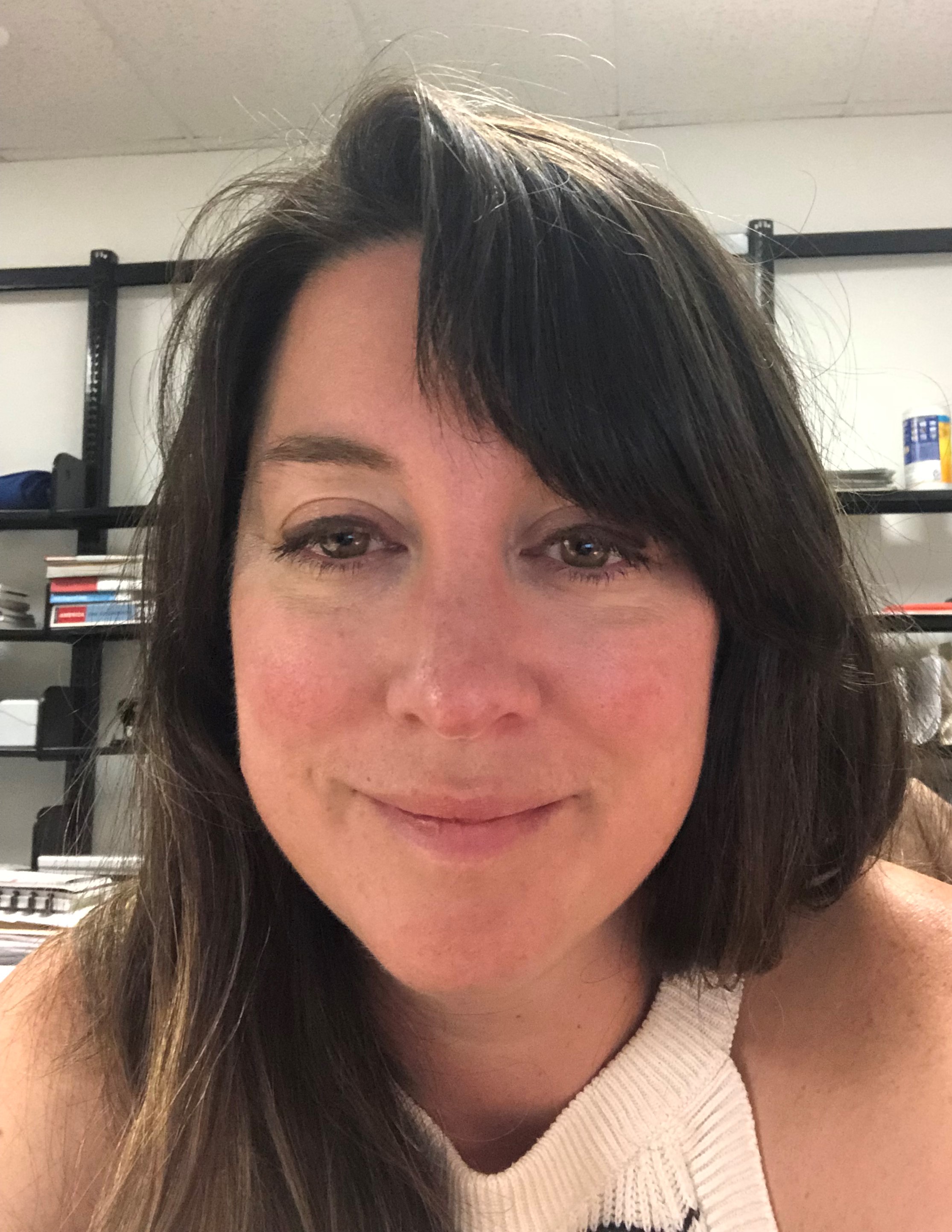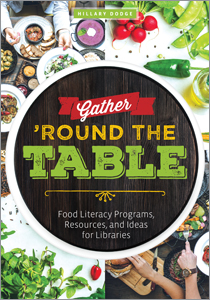Interview: Hillary Dodge on food literacy programs, resources, and ideas
In the view of author Hillary Dodge, with ties to information needs, social justice, and the maker movement, food literacy initiatives are a natural fit for libraries. Her new book Gather ‘Round the Table: Food Literacy Programs, Resources, and Ideas for Libraries doesn't just make that case, it also showcases a host of food literacy programs from libraries across the country. In this interview she talks about the surprising path that led her to write the book, discusses reasons for conducting a community food assessment, and shares some of the fun and educational programs mentioned in her book.
Would you talk a little bit about what first sparked the idea to write a book about food literacy in libraries?
Back in 2016, my husband and I decided to undertake a massive creative project born of our intertwined personal interests. In addition to being a librarian, I am also a writer and my husband is an artist and chef. Our creative project, you see, was to research and write a cookbook on Chilean family meals. We quit our jobs, sold our house and most our things, and relocated our little family of three to the country of Chile in South America. For the next two years, we would travel the length of Chile, from the Atacama Desert in the far north to Patagonia in the far south – adding up over 10,000  miles on the odometer – as we explored cities and villages in search of good food. As we were wrapping up our research on the cookbook and preparing to return to the States, I received an issue of Public Libraries that got me thinking. What literature existed on food literacy and more specifically, food programming in libraries? And so, I began to dig. Although I found several articles on successful food programs and services scattered around the professional literature, there was no single resource for libraries to turn to when considering how to create their own food-related programs. And that's when the proverbial lightbulb went off. As I was already immersed in research on food literacy and food traditions, it occurred to me that I could be the one to suggest the book that I wanted to see available to libraries on this topic.
miles on the odometer – as we explored cities and villages in search of good food. As we were wrapping up our research on the cookbook and preparing to return to the States, I received an issue of Public Libraries that got me thinking. What literature existed on food literacy and more specifically, food programming in libraries? And so, I began to dig. Although I found several articles on successful food programs and services scattered around the professional literature, there was no single resource for libraries to turn to when considering how to create their own food-related programs. And that's when the proverbial lightbulb went off. As I was already immersed in research on food literacy and food traditions, it occurred to me that I could be the one to suggest the book that I wanted to see available to libraries on this topic.
In your view, why should libraries get involved with food literacy?
Libraries are the perfect fit and here's why. As library professionals, we are already offering a plethora of programs and services to our communities. We lead weekly storytimes and guide parents on the tenants of early literacy. We hold community forums and invite authors and speakers to converse and share ideas with our patrons. We have social workers, business centers, makerspaces, and education labs. Already, libraries have asserted themselves as idea hubs and propagators of social good within their communities. Food literacy is just another form of making, another form of adding social good to what we already offer. Patrons can come to the library to find information – a recipe or a particular cookbook. They come to learn something new – how to can preserves or bake a gluten-free birthday cake. They come to join in a social activity – the longest table or an ethnic food fair. They come to have fun – anime club with authentic snacks from Japan or an Iron Chef Ramen competition. Most libraries have a mission, vision, and values that are centered around community-making, information access, education, and entertainment. Food literacy ticks off all those boxes.
Why do you suggest undertaking a community food assessment?
Just as we would perform a community needs assessment to learn more about the information gaps in our communities, a food assessment helps specifically identify food needs and food information gaps. Not only that, food assessments can be used to design or justify a service response as well as plan for the responsible allocation of resources. But wait, there's more! Assessments are excellent processes to build buy-in and engagement and craft value for our communities. While a formal community food assessment can be a lengthy process, it can be made bite-size by partnering with other organizations, businesses, and local government. There is an African proverb that goes: Alone we go faster; together we go farther. Libraries, of course, have already discovered the value in this tenant as demonstrated through our numerous existing and successful partnerships and community collaborations. When designing food literacy programs and services, it naturally follows that we would want to connect with our community experts in identifying and designing programs and services of greatest value to our users. A community food assessment is one sure way to do that. One of things I'm excited to share in my book is a step-by-step guide to planning a community food assessment. Not only do I provide numerous excellent resources, but my book also offers a toolkit of planning worksheets.
In the past, issues of food safety and cleanup have deterred some libraries from offering this kind of programming. What's some advice you'd give to library staff who are interested in making it happen but who might need to overcome objections by library administrators or other stakeholders?
When facing fears and objections, the best thing to do is to educate oneself. I've consulted with libraries and held workshops on the topic of food literacy and best practices for leading cooking demonstrations and other food programs. What I've learned from my participants is that fear and objections can be overcome by demystifying the process, connecting values, and understanding the role the library can play to make a difference in the community. Food literacy is another form of making. Bringing makerspaces and maker equipment into libraries probably felt scary at first also, but the intentional shift to maker-centered learning has expanded our vision of what libraries can be for their communities. Food literacy proposes to do the same. But what's more, you don't need a complete professional kitchen to offer food literacy programming. There are ways to design and scale a food program to work around the specific perimeters (and fears) of individual libraries and communities. Glue guns and 3D printers can be messy and dangerous, but we overcame the fear around those tools through education and training. The same can be said for knives and hot plates. An easy way  to better understand food safety and dispel misconceptions around what we can and can't do with food is to be food safety certified. An online program like ServSafe is a trustworthy and cost-effective way to build competence in this area. Additionally, one of the goals of my book is to make offering food programming less scary. Inside you'll find a program planning quickstart guide, numerous examples of how other libraries have implemented successful food programming, and tons of resources.
to better understand food safety and dispel misconceptions around what we can and can't do with food is to be food safety certified. An online program like ServSafe is a trustworthy and cost-effective way to build competence in this area. Additionally, one of the goals of my book is to make offering food programming less scary. Inside you'll find a program planning quickstart guide, numerous examples of how other libraries have implemented successful food programming, and tons of resources.
In the book you share a variety of innovative food literacy programs drawn from libraries across the country. What are a few of your favorites?
All of them are my favorites! In researching this book, I worked with ALA Editions to send out a survey to the ALA membership where I inquired about successful food programming from all types of libraries around the country. I was overwhelmed by responses and overcome by excitement at what I learned. In selecting the case studies that would be featured in the book, I tried to make sure that a variety of programs and services were represented from small-scale one-off programs and events to larger-scale program series and service responses. I wanted to demonstrate that food literacy could take place in all sizes of libraries with all sizes of budgets. In Lawrenceville, Georgia, the Gwinnett County Public Library celebrated Día de Muertos by creating a community altar and offering a program on food ofrendas in collaboration with a local cultural group. At the La Vista Public Library in Nebraska, teens flocked to the library to attend the popular Teen Bacon Club which met monthly and explored – you guessed it – all things bacon. Additionally, I wanted to showcase a wide range of purpose or tie-in to community value. I wanted to feature programs that were entertaining, educational, focused on community connection, responsive to community need, and propagators of social good. In Dracut, Massachusetts, the Parker Memorial Library responded to a "right-to-farm" designation by offering Backyard Chicken Basics with community experts to dispel myths and guide residents in responsible chicken-keeping. In Rhode Island, the Providence Public Library undertook a year-long healthy-eating initiative in response to the city's first food plan. They designed a series of programs and exhibits to educate and showcase the history of food in their community. From the Mobile Kitchen at the Pikes Peak Library District in Colorado Springs, Colorado to the Edible Education Garden at the Lake Anne Elementary School in Reston, Virginia to the Food Ed Food Truck Business program offered by the Mid-Continent Public Library in Kansas City, Missouri, I am thrilled to share so many interesting and exciting food literacy programs in the pages of Gather 'Round the Table. I hope this book inspires other libraries to undertake the good work of responding to food literacy needs in their communities. And I would love to hear about the successes of other libraries. You can connect with me online at hillarydodge.com.
Learn more at the ALA Store.
